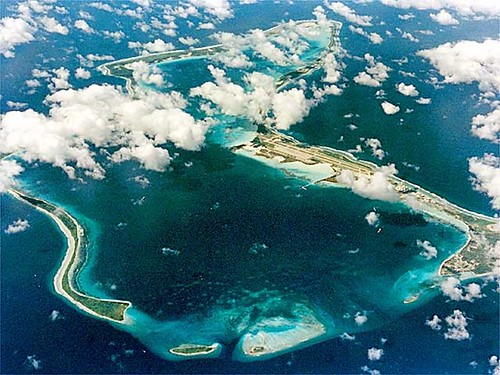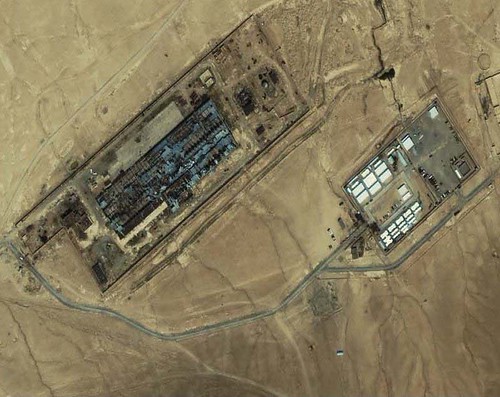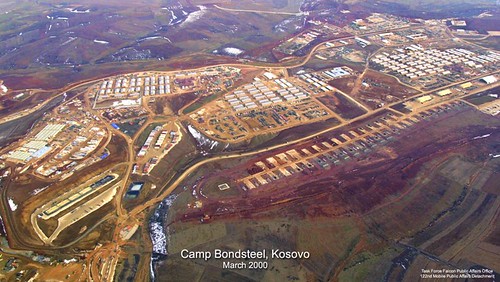Baseworld Archipelago Meltdown

[Image: Diego Garcia "Camp Justice" is a British territory mostly populated by the US military, and is the largest of fifty-two islands which form the Chagos Archipelago, located in the heart of the Indian Ocean.]
Almost answering me from a previous post about how much real estate is dedicated around the world to underground military landscapes, Chalmers Johnson instead describes the meltdown of the American baseworld archipelago as it tries to endure the legacy of Rummy’s flexible military posturing around the globe. From his newest book, Nemesis, he cites the Base Structure Report, an annual inventory of the real property that is owned around the world by the Defense Department from 2002 to 2005.
In a classic statement, he writes, “Once upon a time, you could trace the spread of imperialism by counting up colonies. America's version of the colony is the military base; and by following the changing politics of global basing, one can learn much about our ever more all-encompassing imperial "footprint" and the militarism that grows with it.”

[Image: "The Salt Pit" CIA Interrogation Facility outside Kabul, compliments of Global Security.]
So, from this meaty excerpt of Nemesis printed here, Johnson places the total of America's military bases in other people's countries in 2005 at 737, and quickly points out, that thirty-eight large and medium-sized American facilities spread around at this time – “mostly air and naval bases for our bombers and fleets” – mimics Britain's thirty-six naval bases and army garrisons at its imperial height in 1898. And, even more interesting, he says, is that the Roman Empire at its height in 117 AD required thirty-seven major bases to oversee a geography that ranged from Britannia to Egypt, and Hispania to Armenia. “Perhaps the optimum number of major citadels and fortresses for an imperialist aspiring to dominate the world is somewhere between thirty-five and forty.”
In terms of the numbers, the book reports:
Using data from fiscal year 2005, the Pentagon bureaucrats calculated that its overseas bases were worth at least $127 billion -- surely far too low a figure but still larger than the gross domestic products of most countries -- and an estimated $658.1 billion for all of them, foreign and domestic (a base's "worth" is based on a Department of Defense estimate of what it would cost to replace it). During fiscal 2005, the military high command deployed to our overseas bases some 196,975 uniformed personnel as well as an equal number of dependents and Department of Defense civilian officials, and employed an additional 81,425 locally hired foreigners.
The worldwide total of U.S. military personnel in 2005, including those based domestically, was 1,840,062 supported by an additional 473,306 Defense Department civil service employees and 203,328 local hires. Its overseas bases, according to the Pentagon, contained 32,327 barracks, hangars, hospitals, and other buildings, which it owns, and 16,527 more that it leased. The size of these holdings was recorded in the inventory as covering 687,347 acres overseas and 29,819,492 acres worldwide, making the Pentagon easily one of the world's largest landlords.
But, all this is not without many crucial omissions. For instance, Johnson says it does not include major bases held in Kosovo "like Camp Bondsteel which was built in 1999 and maintained ever since by the KBR corporation.” It apparently does not tally Afghanistan, Iraq, Israel, Kyrgyzstan, Qatar, and Uzbekistan, “even though the U.S. military has established colossal base structures in the Persian Gulf and Central Asian areas since 9/11.” Also, is does not include the number of bases owned by other countries that are jointly shared with the American military. Other foreign bases, Chalmers says, are kept secret for fear these other countries will be exposed for colluding with the Americans. Nor does it even begin to include the secret bases such as the CIA’s prison system, or other installations that might begin to associate the American military with imperialism.

[Image: Camp Bondsteel, Kosovo, 2000.]
By military analyst William M. Arkin’s own words, he says that the pentagon’s more nimble strategy or reorganizing the bases with American military forces having already been stretched to the limit, “goes far beyond preparing for reactive contingencies” but rather “reads more like a plan for picking fights in new parts of the world." Or finding less obvious vantages for at least monitoring these parts of the world, or, perhaps even conducting our own dirty business hidden in and amongst them, either ourselves or outsourced to foreign regimes.
Anyway, staggering to think about. The geography of empire, the pentagon’s new map, a baseworld archipelago meltdown where, "if the American people do not find a way to choose democracy over empire -- at least our imperial venture will end not with a nuclear bang but a financial whimper. From the present vantage point, it certainly seems a daunting challenge for any President (or Congress) from either party even to begin the task of dismantling the military-industrial complex, ending the pall of "national security" secrecy and the "black budgets" that make public oversight of what our government does impossible, and bringing the president's secret army, the CIA, under democratic control. It's evident that Nemesis -- in Greek mythology the goddess of vengeance, the punisher of hubris and arrogance -- is already a visitor in our country, simply biding her time before she makes her presence known."
To read more of this excerpt from Johnson’s Nemesis, go here.







0 Comments:
Post a Comment
<< Home